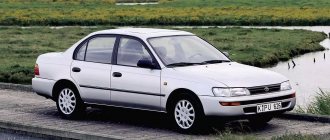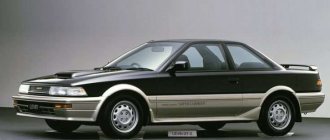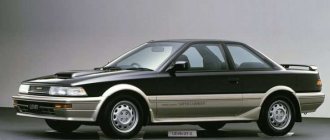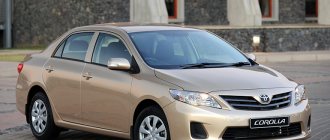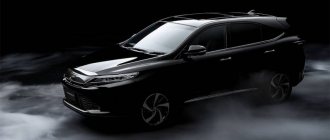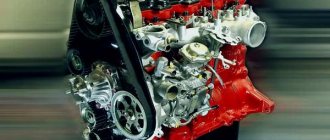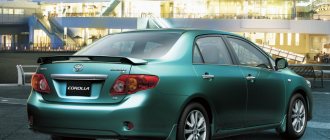The modern minivan market is very oversaturated with various models from various manufacturers. Any automaker with a wide range of models does not leave this segment of the consumer market without attention. Model ranges and configurations not only excite the mind, but also make us think about how the human brain was able to come up with such innovations. However, we should not forget that there are always so-called “pioneers”. In this case, we mean the model that set the pace for the development of modern family cars - Toyota Estima.
Appearance and general information about the model
A Toyota Estima with a hybrid fuel supply system is significantly different in appearance from a model running only on fuel. Estima boasts such new products as:
- New motor, complemented by lithium batteries.
- Wide range of additional options.
- Futuristic exterior.
- New chassis with improved cross-country ability on uneven surfaces.
- Combined fuel-electric power unit. The main difference is fuel economy and performance.
Toyota Estima is one of the first 8-seater cars of the Japanese concern with a hybrid installation. The Prius was taken as the basis for the new development. The Japanese first began to use electrical installations in the early 2000s, and the improvement of the driving characteristics of the Toyota Estima lasted for 6 years. The model has already been restyled more than once, and next year the manufacturer announces the release of an improved car from the assembly line.
Today, the exterior of the Toyota Estima has a streamlined shape, without sharp corners. Narrow xenon headlights extend onto the fenders. The front bumper is equipped with *fog lights* available in the base. The radiator grille is made in the form of a double thin line, covered with chrome, passing through the corporate badge. There is one sliding door for the second and third rows of seats, located on the left (equipped with automatic closing and a closer).
The windshield extends onto the roof, increasing the viewing angle. A panoramic roof and sunroof are optionally available. Side mirrors are square-shaped, with a turn signal. 14 dm wheels come with alloy wheels.
The second and third generation of the Toyota Estima car, reviews
The second generation was produced from 2000 to 2006, was created on the platform of the Toyota Camry model and received a slightly elongated body. Changing the base of the minivan made it possible to change the layout to a front-engine one and made it possible to install a new line of power units. Thus, the lineup includes a 3-liter hybrid V6 with an additional electric motor. There was also a second sliding door on the other side of the body.
The third generation of Toyota Estima appeared in 2006 and is still in production, having already undergone two body restylings. Compared to previous generations, the minivan is currently equipped with a larger set of functions and, as motorists note, a more comfortable interior. The main innovations were a computer parking assistance system (regular and parallel - this is also counted as a plus by its owners), a Synergy Drive hybrid drive system, as well as a second-row seat suspension system with folding cushions. Thanks to the combined Camry-Highlander platform, the car also received a new line of engines, led by a 3.5-liter V6.
It is worth adding that Toyota Estima has become an icon of minivans. It was this car that set and continues to set the pace of development of modern family cars. An excellent analogue is sold in Russia - Toyota Alphard, which will be no less comfortable and enjoyable for trips with the whole family on vacation and on any long journeys. And all the amenities that the car is equipped with will make any trip simply unforgettable.
Specifications
Dimensions of Toyota Estima:
- Length 4 m 80 cm.
- Width 1 m 80 cm.
- Height 1 m 75 cm.
- The weight of the unloaded vehicle is 2 tons 40 kg.
- The car is stock with all-wheel drive.
- Gasoline 4-cylinder engine with a displacement of 2.4 liters and a power of 150 horsepower.
- An electric motor with a capacity of 143 horsepower is installed under the hood, and a mini-engine with 68 horsepower is installed at the rear.
With such characteristics, the car first saw the world in 2006; now options with a diesel engine are available for sale. Acceleration to the first hundred in 10.8 s. Maximum speed 190 km per hour.
Features of the power plant
The traction force of a hybrid car consists of 1 gasoline and 2 electric motors. All-wheel drive is not an option, but a necessity, because the power plants are located not only in the front, but also in the rear. The difference between this version and a regular gasoline Toyota is that the mixed traction method is used. This model differs from front-wheel drive electric cars in the distribution of traction force on all 4 wheels.
Initially, the Toyota Estima hybrid was equipped with a THS-C system, which transmitted 100% of the power to the 2 front wheels. Also, Japanese minivans were equipped with a continuously variable transmission. After restyling, Estima received the THS-2 system (which was previously installed on the Toyota Prius). All-wheel drive paired with a reduction gearbox optimized fuel consumption, traction force, and reduced acceleration time to the first hundred. This option gives you a complete feeling of control over the road.
Previously, the THS-2 system had already been used on other cars of the concern, but its use on Estim made it possible to reduce fuel consumption thanks to a modified 2.4-liter gasoline engine. The car's handling is precise, the wheels react to the slightest touch of the steering wheel. The front wheels are pulled by 150 Japanese horses, the rear wheels by 68. This performance will allow you to fully load the Toyota Estima on long journeys without feeling any discomfort when driving the hybrid, because there will be no loss of traction.
Disadvantages, breakdowns and engine problems
Thread failure on the cylinder head plagued the entire series of AZ engines. As a result, antifreeze ended up on the walls of the block. As a result, Estim's engine overheated. After such a problem, the power unit was thrown into the trash.
Another common problem with Estima engines was engine vibration at low speeds. Experienced mechanics say that this is a manufacturer's defect. If the vibration increases more and more, then the best thing the driver can do is to clean the injectors and EGR valve.
Similar article Technical characteristics of the OM 906 LA engine
Many Toyota cars begin to jerk over time when driving. The fault lies in the throttle valve area. Namely, in its blockage. Therefore, you have to clean it regularly.
Turbine versions are distinguished by the short life span of the turbine and engine. The total lifespan of turbines is about 75 thousand - 100 thousand kilometers of vehicle mileage. Therefore, experienced mechanics advise monitoring the car and especially its engine with a turbine.
For example, on engines such as the 1 GR FE, the cylinder head gasket often burns out. Overheating is not a problem for these motors, because they are specially made for SUVs.
In addition, experienced mechanics note the problem of the fuel resistor, which often occurs in Toyota Estima engines. And the noise and crackling noise coming from the engine when starting the car has become a legendary and characteristic feature of all engines of the GR FE series. In this case, experienced car owners, if the noise and crackling become unbearable, change the clutch.
Every 50 or 100 thousand kilometers the fuel pump leaks. This is also a manufacturer's fault. Although it is easily replaced during service. Therefore, it does not create any special problems for the car owner.
Toyota Estima engines have problems during cold starts at thirty degrees below zero. This malfunction or characteristic feature, depending on how you call it, haunts many car owners in the northern regions. Experienced mechanics advise replacing the mounting block if the fault becomes more and more noticeable each time.
All that can be said about the Japanese manufacturer and its brainchildren is quality and reliability. Despite some shortcomings, the problems that drivers have on Russian roads are minor ones. All Estim engines are designed to last more than half a million kilometers. They more than surpass this mark.
Similar article Technical characteristics and purchase of an engine for Toyota Ipsum
Fuel consumption
According to the passport data, the average fuel consumption is 5 liters per 100 km in mixed mode. Practical fuel consumption may vary.
Gasoline consumption depends on driving style, as well as octane number:
- A-98 and A-95 will most likely fit into the required 5 liters per hundred.
- A-92 will need at least 5.5 liters. On a flat highway at a speed of 80-90 km per hour, you can achieve a consumption of 4 liters per 100 km.
- When driving uphill and when the minivan is fully loaded, gasoline consumption increases to 6 liters, but this figure is much more efficient than that of the non-hybrid version with a 3.5 liter engine. The electric installation saves fuel by 20%.
Positive feedback from owners
The car as a whole received more flattering reviews, which noted a variety of technical and operational aspects. If we start with the main thing, with the power plant, then first of all we note the efficiency of the units. As already mentioned, in calm city driving conditions you can count on 15-20 km/l, which is very good considering the high power of the Toyota Estima Hybrid minibus. Reviews even talk about 10-12 km/h with 92 gasoline. But, again, a lot depends on the driving style.
In terms of driving comfort, there are no complaints either. Both handling and physical ergonomics inside the cabin are at the highest level. The layout of the seats and the distribution of equipment, of course, are implemented in cramped conditions, but thanks to a solid engineering and design base, the developers were still able to achieve comfort for passengers without loss of functionality. With all the configuration changes, the Toyota Estima Hybrid retained its flexibility in terms of transforming the internal space, which primarily concerns the seats.
Also included in the list of advantages is the proprietary reliability of the components and the design itself. The Japanese have been thinking through the technical base of Estima in detail since the 90s and today, along with a durable frame and high-strength parts, they also offer modern active safety systems with electronic control.
Behavior on the road
It is impossible to draw clear boundaries between driving a hybrid and a gasoline car from the first minute of driving.
- A distinctive feature is the large power when pressing the gas to the floor.
- The supply of electricity and fuel is regulated by a special mechanism, due to which the Toyota Estima minivan behaves more confidently on the road, the wheels clearly follow the steering wheel.
- When overtaking, you don’t have to worry that at some point there won’t be enough power and the kickback will end. The electric motor comes into play where the petrol motor falls short.
Switching from an internal combustion engine to a gasoline power unit on your own should not be abused; the charge will not last long. It is most effective to use lithium batteries on the highway or downhill. In the city, the car turns smoothly, does not twitch at the start, even allows you to *vomit* in traffic jams and at the same time spares the engine. The ground clearance is only 16 cm, which is worth remembering when traveling outdoors. The layout of the bottom is uneven; in some places the ground clearance is only 14 cm.
Advice: in order not to sit down on a bump, it is better to choose a homogeneous road surface for movement.
Reviews for the Toyota Estima engine
Here's what car owners write about Estima engines:
- V Ishnyakov Alexander, 28 years old, Kursk. I bought myself a Toyota minivan with a 1 GR FE engine. It seems this was installed on all Highlander-type jeeps. Completely satisfied. The engine just purrs under the hood and it's a pleasure to drive. Oil and fuel consumption is normal. Although they tell me that this usually happens when the car is new. There is only one problem in winter: it is difficult to start the car. I’m going to go to a car service center, let them see what’s wrong;
- Chelnets Alexander, 40 years old, Moscow. I have long dreamed of owning a minivan to go with my family on picnics outside the city. We have a big family. I bought Estima. Friends said that I would suffer with the engine. Yes, at first there were a lot of problems, since I took the car from my own hands. But having invested about 100 thousand rubles in the engine, I got some candy. The Estim engine does not make noise or buzz. It eats oil and diesel normally. It's a pleasure to drive. Copes with our off-road conditions.
This is how car owners generally speak about Toyota Estima and its engines.
Interior support
The Toyota Estima dashboard with a hybrid installation differs from the gasoline one by the presence of a large LCD screen. The multi steering wheel has control buttons for the telephone, air conditioning and player volume. There are models with 7 or 8 seats to choose from. The chairs are comfortable, soft with armrests. Upholstery: leather or fabric (you can choose the color yourself).
The second and third row of seats ride on rails; they can be easily moved back and folded if there is a need to transport oversized cargo. The dashboard and doors inside are made of hard plastic. For the convenience of the driver and passengers, cup holders are located in the central tunnel and doors. Trunk volume 620 liters.
For safety, belts are installed for each passenger individually, and there are 2 AIRBAG airbags in front. The seats are adjusted for height and backrest tilt mechanically.
On a note:
Separate climate control in the base is only for the front row.
First generation
The first "Estima" was released in 1990. Later, in 1992, the Toyota-Estima-Emina and Lucida-Estima variants appeared, which were distinguished by a slightly shortened body and equipment. The main innovation at that time was the installation of the engine at a certain angle, which gave a special practical meaning to the design. Of course, this arrangement had its negative consequences, namely the difficulty of accessing the engine. But for minor maintenance, for example, replacing spark plugs, a special hatch was made under the front row passenger seat.
For more serious repairs, Toyota Estima was equipped with the SADS (Supplemental Accessory Drive System) system. It implied an unusual design solution, thanks to which the air conditioning compressor, generator and other attachments were located remotely from the engine. To operate the system, a special shaft with a pulley was used.
Equipment
Today, Toyota Estima with a hybrid installation can be purchased in several trim levels. The most popular is with a 2.4 liter gasoline engine, two electric motors and all-wheel drive. Fuel tank volume 70 l. Torque 190 Newton/meter. The car complies with Euro 6 emission standards.
The second and third rows have mounts for child car seats - Isofix. Seat belts are equipped with pretensioners that are deployed during a collision. Emergency Braking Assistant Bas will help you reduce speed as quickly as possible in a critical situation. The traction control system will prevent the car from skidding on a slippery road.
Front and rear disc brakes, ventilated. In stock Toyota Estima hybrid is equipped with power windows. The standard radio and radio will not let you get bored on a long journey. A distinctive feature of the car is right-hand drive; left-hand drive is not available even as an option.
Negative reviews from owners
Throughout its history, the Estima model has never been able to become a leader in the sales ratings of the Japanese manufacturer. This is partly due to belonging to a not-so-popular class of minivans, but even the hybridization of the car with all the positive accents could not seriously change the situation. What turns potential owners of the Toyota-Estima-Hybrid away? Reviews note that problems are still hidden in the basic design parameters, which do not allow the car to reveal its capabilities as a commercial vehicle. As a result, intermediate positioning between a family car and a truck for business.
If we talk about the shortcomings of the new power plant, then in addition to the intrusion of batteries into the cabin through the console, some owners note a decrease in the performance of the power element. There are different opinions on this matter, but even experts emphasize that a Japanese battery can “fade” due to prolonged downtime or thermal effects as a result of welding work near the power unit.


